Shijie Wang
A Survey of Reinforcement Learning for Large Reasoning Models
Sep 10, 2025Abstract:In this paper, we survey recent advances in Reinforcement Learning (RL) for reasoning with Large Language Models (LLMs). RL has achieved remarkable success in advancing the frontier of LLM capabilities, particularly in addressing complex logical tasks such as mathematics and coding. As a result, RL has emerged as a foundational methodology for transforming LLMs into LRMs. With the rapid progress of the field, further scaling of RL for LRMs now faces foundational challenges not only in computational resources but also in algorithm design, training data, and infrastructure. To this end, it is timely to revisit the development of this domain, reassess its trajectory, and explore strategies to enhance the scalability of RL toward Artificial SuperIntelligence (ASI). In particular, we examine research applying RL to LLMs and LRMs for reasoning abilities, especially since the release of DeepSeek-R1, including foundational components, core problems, training resources, and downstream applications, to identify future opportunities and directions for this rapidly evolving area. We hope this review will promote future research on RL for broader reasoning models. Github: https://github.com/TsinghuaC3I/Awesome-RL-for-LRMs
Sticker-TTS: Learn to Utilize Historical Experience with a Sticker-driven Test-Time Scaling Framework
Sep 05, 2025Abstract:Large reasoning models (LRMs) have exhibited strong performance on complex reasoning tasks, with further gains achievable through increased computational budgets at inference. However, current test-time scaling methods predominantly rely on redundant sampling, ignoring the historical experience utilization, thereby limiting computational efficiency. To overcome this limitation, we propose Sticker-TTS, a novel test-time scaling framework that coordinates three collaborative LRMs to iteratively explore and refine solutions guided by historical attempts. At the core of our framework are distilled key conditions-termed stickers-which drive the extraction, refinement, and reuse of critical information across multiple rounds of reasoning. To further enhance the efficiency and performance of our framework, we introduce a two-stage optimization strategy that combines imitation learning with self-improvement, enabling progressive refinement. Extensive evaluations on three challenging mathematical reasoning benchmarks, including AIME-24, AIME-25, and OlymMATH, demonstrate that Sticker-TTS consistently surpasses strong baselines, including self-consistency and advanced reinforcement learning approaches, under comparable inference budgets. These results highlight the effectiveness of sticker-guided historical experience utilization. Our code and data are available at https://github.com/RUCAIBox/Sticker-TTS.
Large-Scale LiDAR-Inertial Dataset for Degradation-Robust High-Precision Mapping
Jul 28, 2025Abstract:This paper introduces a large-scale, high-precision LiDAR-Inertial Odometry (LIO) dataset, aiming to address the insufficient validation of LIO systems in complex real-world scenarios in existing research. The dataset covers four diverse real-world environments spanning 60,000 to 750,000 square meters, collected using a custom backpack-mounted platform equipped with multi-beam LiDAR, an industrial-grade IMU, and RTK-GNSS modules. The dataset includes long trajectories, complex scenes, and high-precision ground truth, generated by fusing SLAM-based optimization with RTK-GNSS anchoring, and validated for trajectory accuracy through the integration of oblique photogrammetry and RTK-GNSS. This dataset provides a comprehensive benchmark for evaluating the generalization ability of LIO systems in practical high-precision mapping scenarios.
HAIBU-ReMUD: Reasoning Multimodal Ultrasound Dataset and Model Bridging to General Specific Domains
Jun 09, 2025Abstract:Multimodal large language models (MLLMs) have shown great potential in general domains but perform poorly in some specific domains due to a lack of domain-specific data, such as image-text data or vedio-text data. In some specific domains, there is abundant graphic and textual data scattered around, but lacks standardized arrangement. In the field of medical ultrasound, there are ultrasonic diagnostic books, ultrasonic clinical guidelines, ultrasonic diagnostic reports, and so on. However, these ultrasonic materials are often saved in the forms of PDF, images, etc., and cannot be directly used for the training of MLLMs. This paper proposes a novel image-text reasoning supervised fine-tuning data generation pipeline to create specific domain quadruplets (image, question, thinking trace, and answer) from domain-specific materials. A medical ultrasound domain dataset ReMUD is established, containing over 45,000 reasoning and non-reasoning supervised fine-tuning Question Answering (QA) and Visual Question Answering (VQA) data. The ReMUD-7B model, fine-tuned on Qwen2.5-VL-7B-Instruct, outperforms general-domain MLLMs in medical ultrasound field. To facilitate research, the ReMUD dataset, data generation codebase, and ReMUD-7B parameters will be released at https://github.com/ShiDaizi/ReMUD, addressing the data shortage issue in specific domain MLLMs.
A Robust Monotonic Single-Index Model for Skewed and Heavy-Tailed Data: A Deep Neural Network Approach Applied to Periodontal Studies
May 04, 2025Abstract:Periodontal pocket depth is a widely used biomarker for diagnosing risk of periodontal disease. However, pocket depth typically exhibits skewness and heavy-tailedness, and its relationship with clinical risk factors is often nonlinear. Motivated by periodontal studies, this paper develops a robust single-index modal regression framework for analyzing skewed and heavy-tailed data. Our method has the following novel features: (1) a flexible two-piece scale Student-$t$ error distribution that generalizes both normal and two-piece scale normal distributions; (2) a deep neural network with guaranteed monotonicity constraints to estimate the unknown single-index function; and (3) theoretical guarantees, including model identifiability and a universal approximation theorem. Our single-index model combines the flexibility of neural networks and the two-piece scale Student-$t$ distribution, delivering robust mode-based estimation that is resistant to outliers, while retaining clinical interpretability through parametric index coefficients. We demonstrate the performance of our method through simulation studies and an application to periodontal disease data from the HealthPartners Institute of Minnesota. The proposed methodology is implemented in the \textsf{R} package \href{https://doi.org/10.32614/CRAN.package.DNNSIM}{\textsc{DNNSIM}}.
CheatAgent: Attacking LLM-Empowered Recommender Systems via LLM Agent
Apr 13, 2025Abstract:Recently, Large Language Model (LLM)-empowered recommender systems (RecSys) have brought significant advances in personalized user experience and have attracted considerable attention. Despite the impressive progress, the research question regarding the safety vulnerability of LLM-empowered RecSys still remains largely under-investigated. Given the security and privacy concerns, it is more practical to focus on attacking the black-box RecSys, where attackers can only observe the system's inputs and outputs. However, traditional attack approaches employing reinforcement learning (RL) agents are not effective for attacking LLM-empowered RecSys due to the limited capabilities in processing complex textual inputs, planning, and reasoning. On the other hand, LLMs provide unprecedented opportunities to serve as attack agents to attack RecSys because of their impressive capability in simulating human-like decision-making processes. Therefore, in this paper, we propose a novel attack framework called CheatAgent by harnessing the human-like capabilities of LLMs, where an LLM-based agent is developed to attack LLM-Empowered RecSys. Specifically, our method first identifies the insertion position for maximum impact with minimal input modification. After that, the LLM agent is designed to generate adversarial perturbations to insert at target positions. To further improve the quality of generated perturbations, we utilize the prompt tuning technique to improve attacking strategies via feedback from the victim RecSys iteratively. Extensive experiments across three real-world datasets demonstrate the effectiveness of our proposed attacking method.
How Can Objects Help Video-Language Understanding?
Apr 10, 2025Abstract:How multimodal large language models (MLLMs) perceive the visual world remains a mystery. To one extreme, object and relation modeling may be implicitly implemented with inductive biases, for example by treating objects as tokens. To the other extreme, empirical results reveal the surprising finding that simply performing visual captioning, which tends to ignore spatial configuration of the objects, serves as a strong baseline for video understanding. We aim to answer the question: how can objects help video-language understanding in MLLMs? We tackle the question from the object representation and adaptation perspectives. Specifically, we investigate the trade-off between representation expressiveness (e.g., distributed versus symbolic) and integration difficulty (e.g., data-efficiency when learning the adapters). Through extensive evaluations on five video question answering datasets, we confirm that explicit integration of object-centric representation remains necessary, and the symbolic objects can be most easily integrated while being performant for question answering. We hope our findings can encourage the community to explore the explicit integration of perception modules into MLLM design. Our code and models will be publicly released.
Stochastic Trajectory Prediction under Unstructured Constraints
Mar 18, 2025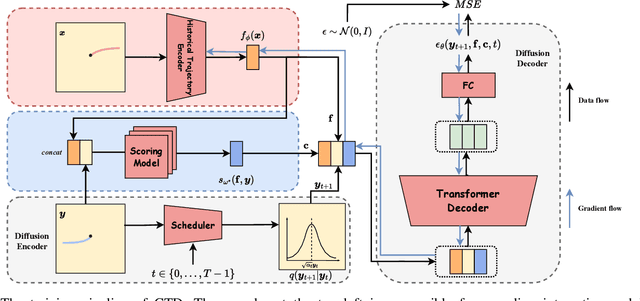
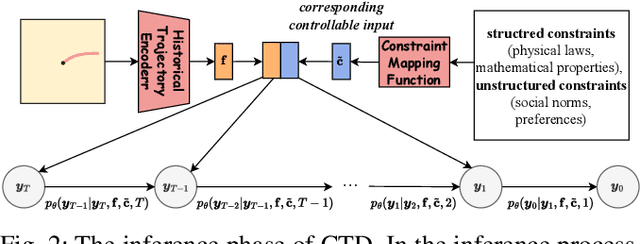
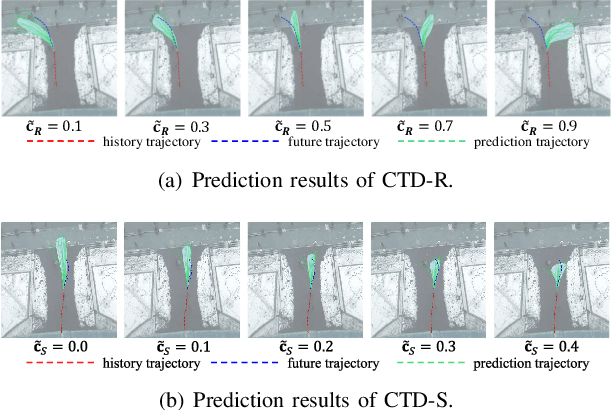
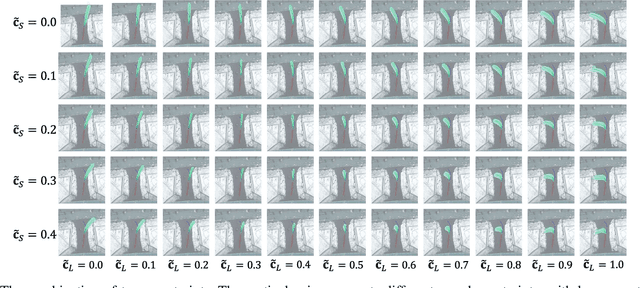
Abstract:Trajectory prediction facilitates effective planning and decision-making, while constrained trajectory prediction integrates regulation into prediction. Recent advances in constrained trajectory prediction focus on structured constraints by constructing optimization objectives. However, handling unstructured constraints is challenging due to the lack of differentiable formal definitions. To address this, we propose a novel method for constrained trajectory prediction using a conditional generative paradigm, named Controllable Trajectory Diffusion (CTD). The key idea is that any trajectory corresponds to a degree of conformity to a constraint. By quantifying this degree and treating it as a condition, a model can implicitly learn to predict trajectories under unstructured constraints. CTD employs a pre-trained scoring model to predict the degree of conformity (i.e., a score), and uses this score as a condition for a conditional diffusion model to generate trajectories. Experimental results demonstrate that CTD achieves high accuracy on the ETH/UCY and SDD benchmarks. Qualitative analysis confirms that CTD ensures adherence to unstructured constraints and can predict trajectories that satisfy combinatorial constraints.
Towards Next-Generation Recommender Systems: A Benchmark for Personalized Recommendation Assistant with LLMs
Mar 12, 2025Abstract:Recommender systems (RecSys) are widely used across various modern digital platforms and have garnered significant attention. Traditional recommender systems usually focus only on fixed and simple recommendation scenarios, making it difficult to generalize to new and unseen recommendation tasks in an interactive paradigm. Recently, the advancement of large language models (LLMs) has revolutionized the foundational architecture of RecSys, driving their evolution into more intelligent and interactive personalized recommendation assistants. However, most existing studies rely on fixed task-specific prompt templates to generate recommendations and evaluate the performance of personalized assistants, which limits the comprehensive assessments of their capabilities. This is because commonly used datasets lack high-quality textual user queries that reflect real-world recommendation scenarios, making them unsuitable for evaluating LLM-based personalized recommendation assistants. To address this gap, we introduce RecBench+, a new dataset benchmark designed to access LLMs' ability to handle intricate user recommendation needs in the era of LLMs. RecBench+ encompasses a diverse set of queries that span both hard conditions and soft preferences, with varying difficulty levels. We evaluated commonly used LLMs on RecBench+ and uncovered below findings: 1) LLMs demonstrate preliminary abilities to act as recommendation assistants, 2) LLMs are better at handling queries with explicitly stated conditions, while facing challenges with queries that require reasoning or contain misleading information. Our dataset has been released at https://github.com/jiani-huang/RecBench.git.
Vision-Based Generic Potential Function for Policy Alignment in Multi-Agent Reinforcement Learning
Feb 19, 2025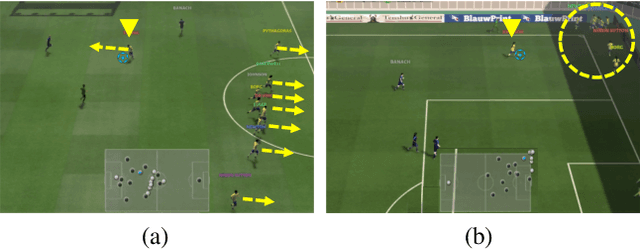
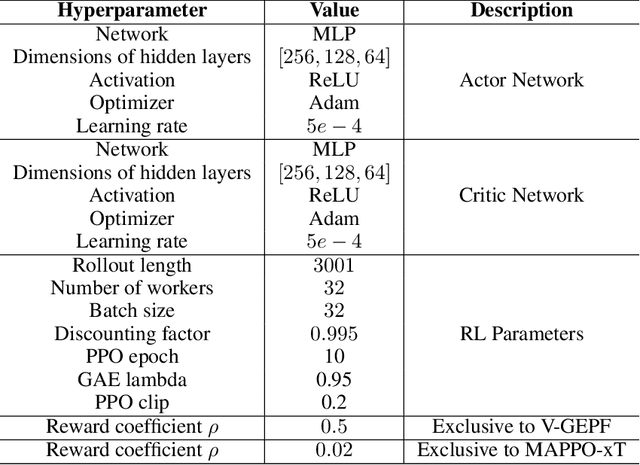
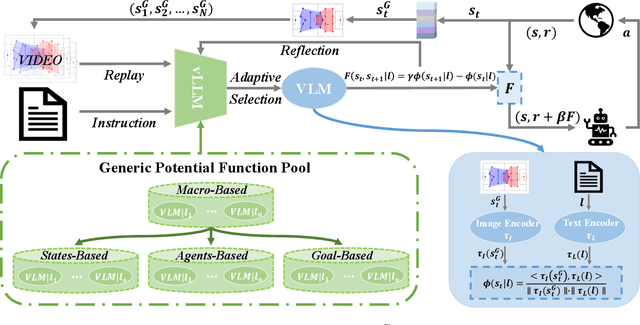
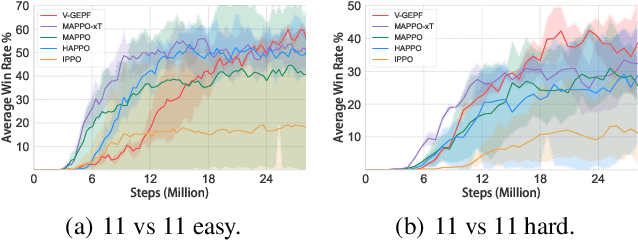
Abstract:Guiding the policy of multi-agent reinforcement learning to align with human common sense is a difficult problem, largely due to the complexity of modeling common sense as a reward, especially in complex and long-horizon multi-agent tasks. Recent works have shown the effectiveness of reward shaping, such as potential-based rewards, to enhance policy alignment. The existing works, however, primarily rely on experts to design rule-based rewards, which are often labor-intensive and lack a high-level semantic understanding of common sense. To solve this problem, we propose a hierarchical vision-based reward shaping method. At the bottom layer, a visual-language model (VLM) serves as a generic potential function, guiding the policy to align with human common sense through its intrinsic semantic understanding. To help the policy adapts to uncertainty and changes in long-horizon tasks, the top layer features an adaptive skill selection module based on a visual large language model (vLLM). The module uses instructions, video replays, and training records to dynamically select suitable potential function from a pre-designed pool. Besides, our method is theoretically proven to preserve the optimal policy. Extensive experiments conducted in the Google Research Football environment demonstrate that our method not only achieves a higher win rate but also effectively aligns the policy with human common sense.
 Add to Chrome
Add to Chrome Add to Firefox
Add to Firefox Add to Edge
Add to Edge